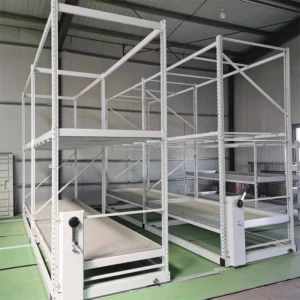Optimizing temperature and humidity levels within a mobile grow rack requires careful management of environmental conditions to create an ideal microclimate for plant growth. Here are several strategies growers can use to achieve this:
- Temperature Control:
- Ventilation: Mobile grow racks can be equipped with ventilation systems, including fans or vents, to regulate airflow and dissipate excess heat. Proper air circulation helps maintain uniform temperatures throughout the rack.
- Thermostats: Installing thermostats with temperature sensors allows growers to monitor and control the temperature within the grow rack. Automated systems can adjust fans or heating elements to maintain the desired temperature range.
- Cooling Systems: In warmer climates or during hot periods, China mobile grow rack supplier growers may use evaporative cooling systems, air conditioning units, or shade cloths to lower temperatures within the grow rack.
- Insulation: Ensuring that the grow rack is properly insulated helps to minimize temperature fluctuations and maintain a stable internal environment.
- Humidity Control:
- Humidifiers and Dehumidifiers: Humidifiers can be used to increase humidity levels within the grow rack, while dehumidifiers remove excess moisture from the air. Automated systems can adjust humidity levels based on preset parameters.
- Misting Systems: Misting systems can be installed to provide a fine spray of water, increasing humidity levels and providing additional moisture to plants, especially in dry environments.
- Monitoring and Adjustment: Regular monitoring of humidity levels using hygrometers allows growers to adjust humidity control systems as needed to maintain optimal levels for plant growth.
- Proper Watering Practices: Overwatering plants can increase humidity levels within the grow rack, while underwatering can lead to dry conditions. Implementing appropriate watering practices helps maintain balanced humidity levels.
- Airflow Management: Proper airflow within the grow rack helps distribute humidity evenly and prevents stagnant air pockets, which can lead to moisture buildup and humidity-related issues.
- Integrated Environmental Control Systems:
- Automated Systems: Integrated environmental control systems can monitor and adjust temperature, humidity, and other environmental factors automatically, based on preset parameters and sensor readings.
- Data Logging and Analysis: Data logging systems record environmental data over time, allowing growers to analyze trends and make informed decisions about environmental control strategies.
- Remote Monitoring: Some systems offer remote monitoring capabilities, allowing growers to monitor and adjust environmental conditions from anywhere using a computer or mobile device.
By implementing these strategies, growers can optimize temperature and humidity levels within mobile grow racks, creating an ideal environment for plant growth and maximizing crop yields.
